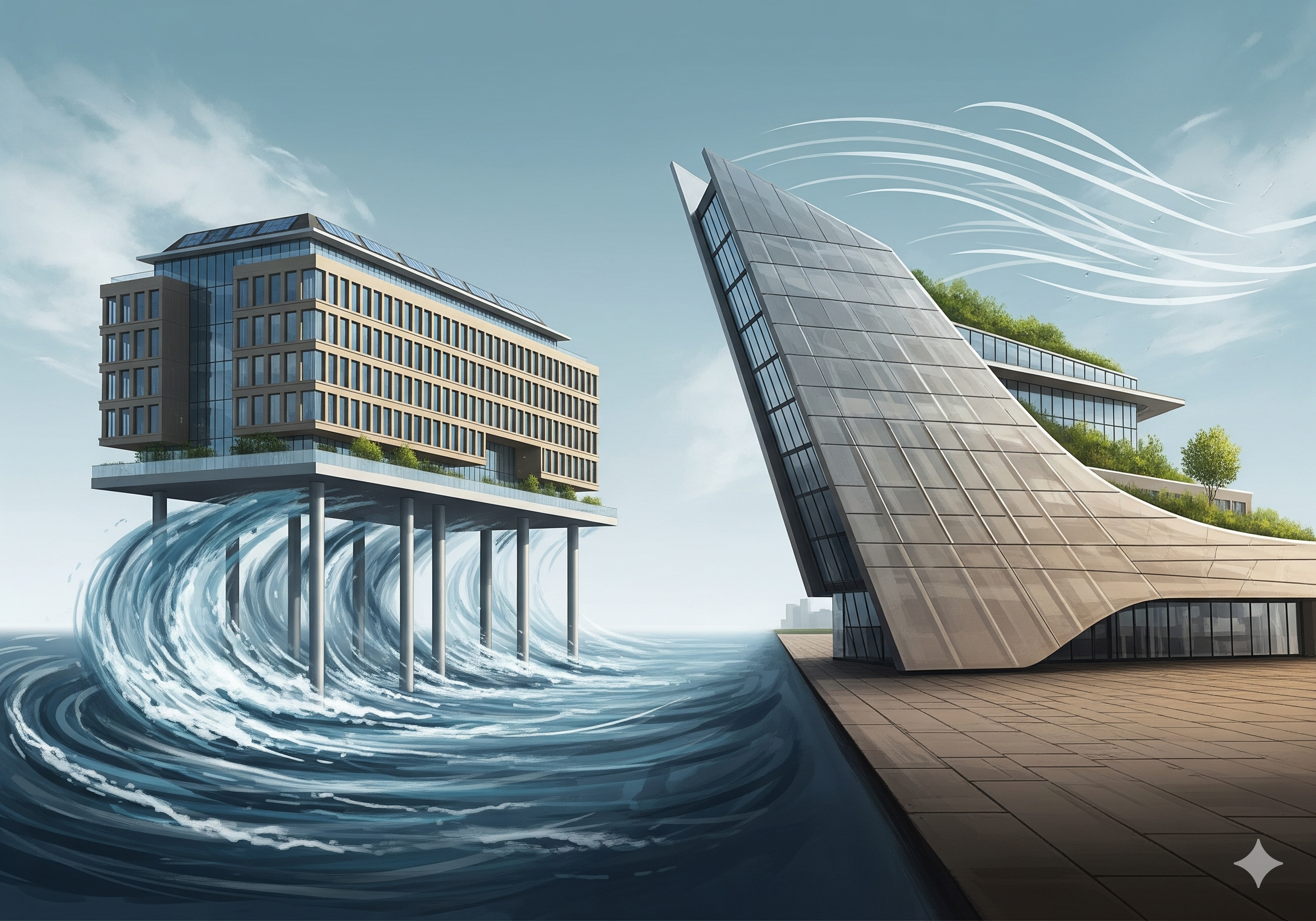Think about the way we’ve built our homes and cities for centuries. We’ve often relied on historical precedent and a stable climate, assuming that the weather patterns of the past will be the weather patterns of the future. But that assumption is no longer valid. The once-rare “100-year storm” is now a frighteningly common occurrence, and once-seasonal threats like wildfires and droughts are now year-round realities. From the rising sea levels in coastal cities to the supercharged winds of hurricanes, our built environment is under attack.
This new reality has forced a profound and urgent shift in the world of architecture and design. Builders, engineers, and urban planners are no longer just designing for aesthetics or function; they are designing for survival. The need for resilience has become the most critical design principle of our time. This is the central thesis of our exploration: how extreme weather is redesigning architecture forever?
This article will delve into the profound changes happening in the world of building and design. We’ll explore the new materials, innovative techniques, and forward-thinking strategies that are being deployed to create a new generation of resilient, climate-adaptive structures. We will show you how architecture is no longer just about shelter, but about a dynamic and intelligent response to a changing planet.
The Background and Context: A Reckoning with Our Designs
For most of history, architecture has been a reflection of its environment. From the thick-walled adobe homes of the desert to the steep-roofed chalets of the Alps, our buildings were a direct response to the climate in which they were built. But the Industrial Revolution and the advent of mass-produced materials led to a more standardized approach. We began to build the same types of structures everywhere, relying on technology like air conditioning and central heating to create a comfortable internal climate, regardless of the external one.
This “one-size-fits-all” approach worked as long as the weather was predictable. But with the rise of climate change, that predictability is gone. The consequences of building in the old ways are now tragically clear.
- Coastal Flooding: Cities like Miami and Venice are experiencing “sunny day flooding,” where king tides and high sea levels inundate streets with no rain.
- Wildfires: The western United States, Australia, and parts of Europe are seeing more frequent and destructive wildfires, turning once-safe homes into tinderboxes.
- Intensified Storms: Hurricanes and tropical storms are becoming more powerful and unpredictable, with winds that can tear apart a traditional home and rainfall that causes catastrophic flooding.
- Extreme Heat: Cities are becoming “heat islands,” with asphalt and concrete trapping heat and leading to dangerous temperatures that can be lethal for vulnerable populations.
This growing threat has forced the architecture and engineering communities to go back to the drawing board. They are recognizing that a building’s first and most important job is to protect its inhabitants from the forces of nature, and that the old ways of doing things are no longer enough. The new discipline of “resilient architecture” is no longer a niche field; it is becoming the new standard.
Detailed Comparison: Traditional vs. Resilient Architecture
To understand the scale of the change, let’s compare the fundamental principles of traditional and resilient architecture in the face of a changing climate.
| Feature | Traditional Architecture | Resilient Architecture |
| Foundation | Rigid. Built on a concrete slab or in-ground foundation, making it vulnerable to flooding and soil erosion. | Elevated or Flexible. Uses stilts, pier foundations, or modular, buoyant designs that can rise with floodwaters. |
| Materials | Conventional. Wood framing, asphalt shingles, and standard siding are highly susceptible to fire, wind, and water damage. | Advanced & Natural. Uses fire-resistant materials (steel, concrete, fire-resistant siding), and materials like bamboo that are both strong and flexible. |
| Roof Design | Pitched for runoff. Designed to shed water, but vulnerable to wind uplift. | Reinforced & Dynamic. Uses stronger fasteners, impact-resistant membranes, and in some cases, a rounded or aerodynamic shape to deflect wind. |
| Water Management | Reactive. Drains and gutters are designed to move water away from the structure, but can be overwhelmed by flash floods. | Proactive. Incorporates “sponge” landscapes, rain gardens, and on-site water storage to absorb water and prevent flooding. |
| Energy Systems | Dependent. Relies on a centralized power grid, which is often the first thing to fail in an extreme weather event. | Self-Sufficient. Incorporates on-site renewable energy (solar, wind), battery storage, and passive cooling systems to function independently. |
| Ventilation | Active. Relies heavily on mechanical HVAC systems, which are vulnerable to power outages. | Passive. Uses natural airflow, orientation, and thermal mass to cool the building without electricity. |
Export to Sheets
The key takeaway from this comparison is that resilient architecture is not just about building stronger; it’s about building smarter. It’s a shift from a defensive posture to a dynamic one, where the building itself becomes an active participant in its environment, adapting and responding to the forces of nature rather than simply resisting them.
Key Features & Benefits of Resilient Design
The move towards climate-adaptive architecture brings with it a host of benefits that extend far beyond simply withstanding a storm.
1. Reduced Costs in the Long Run
While resilient designs can have a higher upfront cost, they lead to massive savings over time. The avoidance of costly repairs after a natural disaster, lower insurance premiums, and reduced energy consumption all add up to a significant return on investment.
2. Enhanced Safety and Security
A resilient building is, first and foremost, a safer building. It provides a secure refuge for its inhabitants during an extreme weather event, protecting not just the structure itself but, more importantly, the lives within it. In a world of increasing uncertainty, this peace of mind is invaluable.
3. Environmental Sustainability
Resilient design and sustainable design are often two sides of the same coin. The use of durable, locally sourced materials, passive heating and cooling systems, and on-site energy generation all contribute to a smaller carbon footprint and a more environmentally responsible built environment.
4. Increased Community Resilience
A single resilient building is a great start, but a community of resilient buildings can become a powerful force. A neighborhood with elevated homes, shared solar microgrids, and communal “safe rooms” can withstand a major event and recover far more quickly than a traditional one. This creates a stronger, more connected community.
5. New Aesthetic Possibilities
The challenge of designing for extreme weather is also sparking incredible creativity. Architects are re-imagining our built environment, creating beautiful and functional structures that are both aesthetically pleasing and scientifically sound. Think of the beauty of a modern home on stilts, or a modular, prefabricated home that is designed to withstand a tornado.
Pros and Cons of Climate-Adaptive Architecture
While the benefits of resilient architecture are clear, the transition to this new paradigm is not without its challenges.
Pros:
- Life and Asset Protection: The most important benefit is the ability to protect lives and property from increasingly dangerous weather events.
- Lower Insurance Premiums: Insurance companies are increasingly offering lower rates for homes and businesses that are built to withstand natural disasters.
- Greater Energy Independence: The incorporation of on-site energy systems makes a building less reliant on a vulnerable power grid.
- Increased Property Value: In at-risk areas, a climate-adaptive building will have a higher value and will be more attractive to buyers.
Cons:
- Higher Upfront Costs: The specialized materials, engineering, and construction techniques can make a resilient building more expensive to build initially.
- Lack of Widespread Adoption: While the demand is growing, the widespread knowledge and expertise in resilient design are still developing, and many builders are not yet equipped to handle these projects.
- Permitting and Building Code Challenges: Local building codes and regulations can sometimes be slow to adapt to new technologies and designs, creating hurdles for innovative projects.
- Aesthetic Limitations (Perception): Some people may find the appearance of certain resilient designs (e.g., homes on stilts) to be less aesthetically pleasing than traditional homes, though this is rapidly changing.
Use Cases: Who Needs to Build for the Future?
While resilient design is an important consideration for everyone, it is absolutely essential for certain regions and types of structures.
- Coastal and Floodplain Communities: Any community near a coastline, a major river, or in a flood-prone area must adopt resilient designs. This includes both new construction and retrofitting existing homes with measures like elevated foundations and water-resistant materials.
- Wildfire-Prone Regions: Communities in forested or arid areas need to prioritize fire-resistant materials, fire-breaks, and landscaping that reduces fire risk.
- Areas with Extreme Heat: Urban centers and desert regions must prioritize passive cooling systems, green roofs, and materials that reduce the heat island effect. This is crucial for public health and energy conservation.
- Critical Infrastructure: Hospitals, fire stations, power plants, and emergency shelters must be built with the highest standards of resilience to ensure they can continue to operate during and after a natural disaster.
FAQs: Your Guide to Resilient Building
What is the difference between a hurricane-proof and a hurricane-resistant home?
A “hurricane-proof” home is a misnomer, as no building can be guaranteed to survive the most powerful storms. “Hurricane-resistant” refers to a building that is engineered and built with specific features—reinforced windows, a strengthened roof, and a secure foundation—to withstand high winds and storm surges, significantly increasing its chances of survival.
Are these designs only for expensive custom homes?
No. While many early resilient designs were high-end, the technology and materials are becoming more accessible and are being incorporated into modular and prefabricated homes. The goal is to make resilient housing an affordable and accessible option for everyone.
Can an existing home be made more resilient?
Yes. Many homes can be retrofitted with resilient features. This can include strengthening the roof-to-wall connections, adding impact-resistant window coverings, installing a battery backup system, or elevating a foundation in a flood-prone area.
What is a “microgrid,” and how does it help a building?
A microgrid is a localized power grid that can operate independently from a city’s main power grid. In a resilient building, this can mean a combination of on-site solar panels, battery storage, and a generator. If the main grid goes down, the building can still generate its own power and function normally.
What is passive design?
Passive design refers to a building that is designed to maintain a comfortable temperature without the use of mechanical systems. This can include features like a strategic building orientation to capture winter sun, overhangs to block summer sun, and natural ventilation systems to cool the interior.
Conclusion: The Final Verdict on a New Era of Architecture
The forces of nature are now forcing our hand. The era of building with a blind eye to the climate is over. The question is no longer whether we should build with resilience in mind, but how quickly we can adapt to this new reality. How extreme weather is redesigning architecture forever? is not a question of possibility, but a statement of fact.
The future of architecture will not be defined by a single style or a new material, but by a new mindset. It will be defined by a deep respect for the forces of nature and an unwavering commitment to building structures that can withstand them. It’s a shift from building shelters to building sanctuaries, from simply housing people to truly protecting them.
The final verdict is a powerful call to action: we must leave behind the old paradigms and embrace a new era of resilient design. The homes and cities we build today will determine our ability to thrive in the climate of tomorrow. The future is not just about adapting to the weather; it is about building a world that can stand up to it.







Leave a Reply